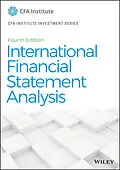Better analysis for more accurate international financial valuation International Financial Statement Analysis, 4th Edition provides the most up-to-date detail for the successful assessment of company performance and financial position regardless of country of origin. The seasoned experts at the CFA Institute offer readers a rich, clear reference, covering all aspects from financial reporting mechanics and standards to understanding income and balance sheets. Comprehensive guidance toward effective analysis techniques helps readers make real-world use of the knowledge presented, with this new third edition containing the most current standards and methods for the post-crisis world. Coverage includes the complete statement analysis process, plus information on income tax accounting, employee compensation, and the impact of foreign exchange rates on the statements of multinational corporations.
Klappentext
Better analysis for more accurate international financial valuation
The Fourth Edition of International Financial Statement Analysis includes up-to-date information for the successful assessment of company performance and financial position regardless of an organization's country of origin. Written by the experts at CFA Institute, this important resource offers a clear reference that covers all aspects of financial statement analysis, from the sources of information used in financial statement analysis through strategies for evaluating financial statement notes and supplementary information in order to form expectations and make recommendations about a company's future performance and financial position.
This comprehensive guide includes effective analysis techniques that help present the knowledge in real-world application. The Fourth Edition also contains current standards and methods and includes the complete statement analysis process. Information on income tax accounting, employee compensation, and the impact of foreign exchange rates on the statements of multinational corporations is also included.
International Financial Statement Analysis, Fourth Edition offers the latest rules and best practices, with clarity and expert advice.
Zusammenfassung
Better analysis for more accurate international financial valuation International Financial Statement Analysis, 4th Edition provides the most up-to-date detail for the successful assessment of company performance and financial position regardless of country of origin. The seasoned experts at the CFA Institute offer readers a rich, clear reference, covering all aspects from financial reporting mechanics and standards to understanding income and balance sheets. Comprehensive guidance toward effective analysis techniques helps readers make real-world use of the knowledge presented, with this new third edition containing the most current standards and methods for the post-crisis world. Coverage includes the complete statement analysis process, plus information on income tax accounting, employee compensation, and the impact of foreign exchange rates on the statements of multinational corporations.
Inhalt
Preface xv
Acknowledgments xvii
About the CFA Institute Investment Series xix
Chapter 1 Introduction to Financial Statement Analysis 1
Learning Outcomes 1
1. Introduction 1
2. Roles of Financial Reporting and Financial Statement Analysis 2
3. Primary Financial Statements and Other Information Sources 8
3.1. Financial Statements and Supplementary Information 9
3.2. Other Sources of Information 28
4. Financial Statement Analysis Framework 28
4.1. Articulate the Purpose and Context of Analysis 30
4.2. Collect Data 30
4.3. Process Data 31
4.4. Analyze/Interpret the Processed Data 31
4.5. Develop and Communicate Conclusions/Recommendations 32
4.6. Follow-Up 32
5. Summary 32
References 34
Practice Problems 34
Chapter 2 Financial Reporting Standards 37
Learning Outcomes 37
1. Introduction 37
2. The Objective of Financial Reporting 38
3. Standard-Setting Bodies and Regulatory Authorities 39
3.1. Accounting Standards Boards 39
3.2. Regulatory Authorities 41
4. The International Financial Reporting Standards Framework 46
4.1. Qualitative Characteristics of Financial Reports 46
4.2. Constraints on Financial Reports 48
4.3. The Elements of Financial Statements 49
4.4. General Requirements for Financial Statements 50
5. Comparison of IFRS with Alternative Reporting Systems 53
6. Monitoring Developments in Financial Reporting Standards 55
6.1. New Products or Types of Transactions 55
6.2. Evolving Standards and the Role of CFA Institute 55
7. Summary 57
Practice Problems 58
Chapter 3 Understanding Income Statements 61
Learning Outcomes 61
1. Introduction 62
2. Components and Format of the Income Statement 62
3. Revenue Recognition 68
3.1. General Principles 69
3.2. Accounting Standards for Revenue Recognition 70
4. Expense Recognition 73
4.1. General Principles 74
4.2. Issues in Expense Recognition 78
4.3. Implications for Financial Analysis 83
5. Non-Recurring Items and Non-Operating Items 84
5.1. Discontinued Operations 84
5.2. Unusual or Infrequent Items 85
5.3. Changes in Accounting Policies 86
5.4. Non-Operating Items 89
6. Earnings per Share 90
6.1. Simple versus Complex Capital Structure 90
6.2. Basic EPS 91
6.3. Diluted EPS 92
6.4. Changes in EPS 98
7. Analysis of the Income Statement 99
7.1. Common-Size Analysis of the Income Statement 99
7.2. Income Statement Ratios 101
8. Comprehensive Income 103
9. Summary 106
Practice Problems 108
Chapter 4 Understanding Balance Sheets 113
Learning Outcomes 113
1. Introduction 113
2. Components and Format of the Balance Sheet 114
2.1. Balance Sheet Components 115
2.2. Current and Non-Current Classification 116
2.3. Liquidity-Based Presentation 117
3. Current Assets and Current Liabilities 118
3.1. Current Assets 118
3.2. Current Liabilities 123
4. Non-Current Assets 127
4.1. Property, Plant, and Equipment 128
4.2. Investment Property 129
4.3. Intangible Assets 129
4.4. Goodwill 132
4.5. Financial Assets 135
4.6. Deferred Tax Assets 138
5. Non-Current Liabilities 139
5.1. Long-term Financial Liabilities 140
5.2. Deferred Tax Liabilities 140
6. Equity 141
6.1. Components of Equity 141
6.2. Statement of Changes in Equity 144
7. Analysis of the Balance Sheet 145
7.1. Common-Size Analysis of the Balance Sheet 146
7.2...
